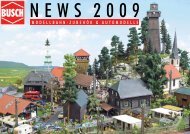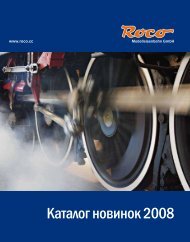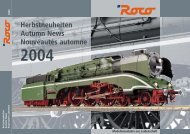SwitchPilot & SwitchPilot Extension - DCC Concepts
SwitchPilot & SwitchPilot Extension - DCC Concepts
SwitchPilot & SwitchPilot Extension - DCC Concepts
You also want an ePaper? Increase the reach of your titles
YUMPU automatically turns print PDFs into web optimized ePapers that Google loves.
4Features of <strong>SwitchPilot</strong>5. Features of <strong>SwitchPilot</strong>The <strong>SwitchPilot</strong> is designed for activating turnouts, signals,magnetic un-couplers, light bulbs and other stationary loads onyour model train layout.It has four outputs for switching of up to 4 solenoids (e.g.: turnoutmotors) or 8 loads such as un-couplers or light bulbs. Eachoutput can be programmed individually for continuous or pulsedoutput with variable pulse duration or blinking.Thus it is possible to connect light bulbs or LEDS without anyadditional relays. Automatic fading assures prototypical run-upand shut-down of signal lamps.In addition two commercially available RC-servos for hobbyapplications may be wired directly to the <strong>SwitchPilot</strong>. Their speedand end position can be adapted as required.The <strong>SwitchPilot</strong> can be supplied with power either from the digitalsystem or from an external AC- or DC-power source.The <strong>SwitchPilot</strong> is multi protocol capable and therefore can eitherbe operated with command stations as per the Märklin®-Motorola® system (e.g.: 6021, Central Station®) or with <strong>DCC</strong>compliant command stations. As laid down in the standards the<strong>SwitchPilot</strong> has to be activated with accessory addresses.Due to the integral <strong>DCC</strong> RailCom® - transmitter it is possible toprovide status feed back of the accessory to the command station.For instance an ESU ECoS command station can then display themanually activated change of status.The <strong>SwitchPilot</strong> contains a full bridge rectifier. There is o needfor separate power modules. Of course the transistor outputs of<strong>SwitchPilot</strong> are electronically protected against overload and shortcircuit.5.1. Features of <strong>SwitchPilot</strong> <strong>Extension</strong>For operating motor drives for turnouts or for the polarisation ofthe frogs you require a relay with potential free contacts. For thispurpose each <strong>SwitchPilot</strong> can be connected to a <strong>SwitchPilot</strong> <strong>Extension</strong>which can be plugged into the side of the <strong>SwitchPilot</strong>and receives its power from it.Each <strong>SwitchPilot</strong> <strong>Extension</strong> module has 4 by 2 relay outputs thatare operated in parallel to the corresponding outputs of the<strong>SwitchPilot</strong>. This corresponds to the established k84-solution.6. The outputs in detailThe <strong>SwitchPilot</strong> has a total of 8 transistor outputs that are groupedin four pairs 1 to 4. Each pair has two outputs, OutA and OutB.there are also two separate servo outputs.The transistor outputs can be set to continuous, to pulsed poweror to alternating blinking.Pulsed output:If the output is set to pulse operation it will be activated as soonas a command is received. At the same time a timer startscounting: the “on-time” (duration of pulse) is determined by apre-programmed value. The output cannot be active for longeror shorter than this value. Should you let go of the button beforethe end of the first pulse then the output remains active until thepre-determined time has been reached. If you press the buttonlonger than the pre-determined pulse duration then the outputis switched off even though the button is still pressed.The limitation of the pulse duration helps avoid damage tosolenoids.The pulse duration can be set in such a way that the outputs areactive as long as the button on the control panel is pressed. Thisoperating mode is compatible with Märklin® k83 decoders.Continuous output:Pressing the appropriate button on the control panel (e.g.: “red”for Märklin® central units or „+“ for Lenz Digital Plus®) switcheson the first output Out A. It remains on until the correspondingbutton for output Out B is activated. Out A and Out B work likea change over switch.Logically this operating mode complies with the Märklin® k84decoder.
5Operating modes of the <strong>SwitchPilot</strong>Alternating blinker:In this mode the terminals Out A und Out B of an output will beactivated alternately. This is quite useful for the blinking red lightsat level crossings amongst others.The “on-time” can be set in the same fashion as the pulseduration.Subject to the pulse duration and also in continuous mode itmay happen that several outputs are on at the same time. Pleasenote that the total current of all connected loads must not exceedthe total permitted load of the decoder, namely 3.0 A.7. Operating modes of the <strong>SwitchPilot</strong>The <strong>SwitchPilot</strong> has a switch to select different operating modes.Thus you can easily set the desired mode (refer to picture 1).Therefore “programming” is not necessary for most standardapplications.This switch only operates the four transistor output pairs 1 to 4.The servo outputs 5 and 6 are not affected.7.1. k83 modeWhen you push the slide switch into the k83 position then theoutputs 1 to 4 will be switched to pulse operation regardless ofthe programmed settings. The <strong>SwitchPilot</strong> behaves exactly like aMärklin® k83. Use this mode whenever you want to operateconventional solenoid drives.7.2. k84 modeIn the k84-mode the outputs 1 to 4 will be set to continuousoutput regardless of any pre-programmed settings. The<strong>SwitchPilot</strong> behaves exactly like a Märklin® k84.Use this mode to operate LEDS or light bulbs and whenever youdo not require any specific programming.7.3. User modeThe user mode is switched on by setting the switch for selectingthe operating mode into the centre position. Only in this modethe outputs 1 to 4 will behave according to the software controlledsettings.
Connecting to the digital systemi) i)i) i) h) g) f) e) d)c)U+ GNDi)i)k)i)i)a) a) a) a)b)68. Connecting to the digital systemWe recommend setting all parameters of the <strong>SwitchPilot</strong> priorto installing the unit on your layout.8.1. Terminals of the <strong>SwitchPilot</strong> / <strong>SwitchPilot</strong> <strong>Extension</strong>Figure 1 shows the <strong>SwitchPilot</strong> together with the optional<strong>SwitchPilot</strong> <strong>Extension</strong> module.a) Wire turnouts, signals, un-couplers or similar devices to theterminals of the (transistor) outputs 1 to 4. The terminals FB Aand FB B are used for status feedback of the device.b) This multi-pin connector serves to wire two commerciallyavailable RC-Servos (e. g.: Graupner®, Futaba® or ESU) andrepresents the outputs 5 and 6 of the <strong>SwitchPilot</strong>.Figure 1: <strong>SwitchPilot</strong> and <strong>SwitchPilot</strong> <strong>Extension</strong>c) The power supply for the <strong>SwitchPilot</strong> and all the devicesconnected to it are wired to the terminals Pw A und Pw B.Both AC- and DC power supplies as well as the digital trackvoltage can be used.d) The screw terminals Trk A and Trk B connect the <strong>SwitchPilot</strong>with the power output of a (booster) command stationtransmitting the digital commands.e) The switch controlling the operating modes allows you toselect any of the supported modes such as k83, user modeand k84-mode (also compare with chapter 7).f) The LED in conjunction with theg) programming button helps you to set the digital address ofthe <strong>SwitchPilot</strong> and <strong>SwitchPilot</strong> <strong>Extension</strong>. This process isdescribed in chapter (9.3).
7h) The extension socket / plug connect the <strong>SwitchPilot</strong> and the<strong>SwitchPilot</strong> <strong>Extension</strong> mechanically and electrically.i) The outputs marked 1 to 4 offer one relay output A and B thatcan be switched together. Each relay output corresponds withthe respective output of the <strong>SwitchPilot</strong>: If the output Out Aof the <strong>SwitchPilot</strong> is active the terminal 1 and COM of therelay output are also active. If the output Out B of the<strong>SwitchPilot</strong> is active then the terminals 2 and COM areelectrically connected. Unlike the transistor outputs the relayoutputs always work as continuous outputs.k) Two screw terminals providing U+ (rectified track voltage) GND(negative supply). This voltage can be used to feed motor drives(compare with chapter 8.5.3.)8.2. Power supply from the digital systemFor smaller layouts with only a few devices to be switchedsimultaneously the power supply of the digital system may beused.8.3 Separate power supplyFor larger layouts with many devices controlled by <strong>SwitchPilot</strong>sand simultaneously active we recommend to utilise a separatepower supply; in this manner the power for switching the devicesis not drawn from the track and thus reduces the load on thedigital system.Only use commercially available equipment designed for modeltrains and also take note of the maximum voltage as stated inchapter 11 in order to avoid any potential damage.connect to track outputof digital systemconnect totransformerConnect to track outputof digital systemFigure 3: separate power supply for <strong>SwitchPilot</strong>Figure 2: <strong>SwitchPilot</strong> uses digital system for power supplyThe screw terminals Pw A and Pw B are wired in parallel to theterminal Trk A and Trk B.8.4. Wiring the <strong>SwitchPilot</strong> <strong>Extension</strong>The <strong>SwitchPilot</strong> <strong>Extension</strong> module is connected by inserting itinto the multi-pin connectors on the side of the <strong>SwitchPilot</strong>; pushuntil the retaining clips make positive contact.Please also refer to figure 1.The internal logic and relays of the <strong>SwitchPilot</strong> <strong>Extension</strong> modulereceive power from the <strong>SwitchPilot</strong>.
8Wiring the outputsb)a)c)R8.5 Wiring the outputs8.5.1. Connecting double-coil solenoidsYou may use all commercially available double-coil solenoid drivesby all major manufacturers with <strong>SwitchPilot</strong>. Figure 4 shows howto wire output 1:a) The common wire of the solenoid is wired to screwterminal C.b) The wire leading to the first coil is connected to terminal OutA.c) The wire leading to the second coil is connected to terminalOut B.Figure 4: Wiring the transistor outputs 1 - 4Should the aspect shown on your control panel not be as desired(in other words: if straight and diverging route are exchanged)simply swapp the wires between terminals Out A and Out B.<strong>SwitchPilot</strong> can also handle Peco turnouts. However, their currentconsumption is so high that you must adjust the overload settingof the <strong>SwitchPilot</strong>. Please refer to chapter 9.4.2 for details.
8.5.2. Wiring daylight signals and light bulbs or LEDsIf you use daylight signals with incandescent lamps (light bulbs)or LEDs you must set the corresponding output to continuousmode.If the signal has incandescent lamps as shown for output 2 infigure 4 you may wire the lamps directly to the terminals of the<strong>SwitchPilot</strong>.In order to limit the current for signals with LEDs a resistor mustbe wired in series with the LEDs. This is shown for output 4 infigure 4.Please check if your signal already has a built-in resistor. Applyingpower without this resistor will destroy the LEDs immediately!If there is no resistor in place you must wire this resistor marked“R” in series to the LEDs. Subject to the supply voltage and thedesired brightness of the signal the resistor should have a ratingof about 1 kohm to 2.2 kohm.The screw terminal C of each output has positive potential.Therefore the cathode of the LEDs must be connected to theterminals Out A respectively Out B.+ -MU+ GNDPower Supply of Motor(could be separately)Figure 5: Motor drive used with <strong>SwitchPilot</strong> <strong>Extension</strong>8.5.3. Wiring a motor driveThe <strong>SwitchPilot</strong> can operate motor drives for turnouts with theaid of the <strong>SwitchPilot</strong> <strong>Extension</strong>. The direction of the motor isreversed by changing the polarity of the voltage on the motorterminals thus changing the position of the turnout or the aspectof a semaphore signal.Only use motor drives with limit stop contacts to avoid overheatingor a burnout of the motor. The relay outputs of the <strong>SwitchPilot</strong><strong>Extension</strong> always connect the supply voltage to the load.A motor drive is wired as shown in figure 5. The two wires forthe power supply of the motor drive should be connected to thescrew terminals as shown. Alternatively, they can be alsoconnected to a separate DC-source and thus do not draw anycurrent from the digital system.Please take note of the permitted maximum supply voltage ofyour motor drive as stated in its manual.a) b)Figure 6: Wiring the feedback contacts9
10Wiring the outputs8.5.4. Wiring feed back contactsThe <strong>SwitchPilot</strong> can report the actual aspect or position of theturnout to the command station via RailCom®. The turnout musthave some extra contacts for this. Figure 6 on page 9 illustratesthis situation:a) Connecting a motor of a turnout with limit stop contacts.Connect the terminals Out A with FB A and Out B with FB B.b) Connecting a motor with separate feedback contacts: connectthe feedback contacts with terminal FB A respectively FB Band the common wire of the feedback contacts to terminal C.How the status (feedback) is displayed depends on your commandstation. The ESU ECoS®-command station can display the statuson the turnout control panel with software 1.1.0 and higher.8.5.6. Wiring a servoThe two servo outputs are something special. They operateindependently from the outputs 1 to 4 but can also be assignedin parallel to output 1 and 2 if so desired. For instance you coulduse a servo for activating a turnout while simultaneously changingthe signal aspect with the corresponding transistor output.All commercially available RC-servos for hobby applications maybe used. They must have a three-pole terminal and operate on apositive pulse. The <strong>SwitchPilot</strong> provides 5V to the servo.8.5.5. Polarising electric frogsYou may polarise (supply power of the correct polarity) to theelectro-frog of your turnout.Figure 7: Polarizing electric frogs with <strong>SwitchPilot</strong> <strong>Extension</strong>figure 8: Servo connectionSimply insert the wire from the servo into the appropriate socketof the <strong>SwitchPilot</strong>. Generally the white or orange wire is used forthe pulsed outputs of the servo.Please refer to the wiring diagrams on the housing of the<strong>SwitchPilot</strong>. Incorrect connections may destroy either the servoor the <strong>SwitchPilot</strong>!The servo outputs can be configured individually as per chapter9.4.3.
11Programming the <strong>SwitchPilot</strong>9. Programming the <strong>SwitchPilot</strong>First you have to assign the turnout number or address of eachoutput by giving the <strong>SwitchPilot</strong> the desired address. The easiestway of assigning the address is by means of the programmingbutton. Please refer to chapter 9.3.Then you can program certain CVs in order to set the operatingmode of each output.The CVs for extended settings are supported by all <strong>DCC</strong>compatible digital command station. This programming cannotbe done with Motorola®-command stations (such as 6021,Märklin® Central Station®).However, despite the fact that you cannot program the outputswith the Motorola®-system you can still set them to a k83-respectively k84-compatible operating mode by means of theswitch selecting the operating mode.9.1. Factory settingsOutputs 1 to 4 are pre-set to address 1 to 4 with all outputs setto single pulse mode with 520 msec pulse duration. The servooutputs respond to addresses 5 and 6 and require 3.75 sec for afull movement with both end positions being about 50% of thepossible distance of the starting point.With the exception of the address (turnout number) the<strong>SwitchPilot</strong> responds to CV-settings in user mode only.9.2. Assigning turnout addressesIn digital systems turnouts are organised in groups of four. Turnout1 – 4 represent the first group, turnouts 5 – 8 the secondgroup, and so on. Depending on the digital system the numberof available groups may vary: Märklin® Digital supports a totalof 64 groups (and thus can activate 256 turnouts), while the<strong>SwitchPilot</strong> supports 511 groups in <strong>DCC</strong> mode (and thus 2044turnouts).You can assign such a group and an address to each group ofyour <strong>SwitchPilot</strong>. Therefore the outputs 1 - 4 of the <strong>SwitchPilot</strong>may activate the numbers 1 - 4, 5 – 8, 9 – 12 and so forth, rightup to 2041 – 2044 (in <strong>DCC</strong> mode).The desired address is stored in CVs 1 and 9.Most digital systems (including the ECoS) show the turnoutnumber rather than the actual address on the control panel.A separate address can be assigned to the servo outputs, whichis stored in CVs 35 / 36. The <strong>SwitchPilot</strong> supports two independentaddresses for the servo outputs.9.3. Programming addresses with the programming buttonYou may program the addresses with the aid of the programmingbutton without any complicated procedure on the programmingtrack. We recommend to proceed as follows:You must use this method if you work with a Märklin® Motorola®central unit (6021, Central Station®) or if you want to changethe addresses of the turnouts after installation of the decoder onyour layout.9.3.1. First address for outputs 1 - 41. Select the turnout number (address) on your digital systemthat you want to assign to the first output of your <strong>SwitchPilot</strong>.Proceed as per the instructions of your handheld throttle oryour command station as if you wanted to switch the respectiveturnout (for ECoS users: refer to chapter 13ff in the ECoSmanual).2. Turn on the power supply of your layout.3. Press the programming button and hold it long enough until(after about two seconds) the LED blinks as follows: short,pause, short, pause, and so on.4. You may now release the button, the decoder is in learningmode.5. Now switch the turnout you have selected in step 1 on yourhandheld controller or your command station. It is immaterialwhether you switch from “straight” to “diverging route” orvice versa.
12Programming the <strong>SwitchPilot</strong>6. Once the decoder has “understood” the address it will confirmthis by lighting up the LED for one second.7. Then the <strong>SwitchPilot</strong> goes back to the normal operating modeand the LED extinguishes.Should you have programmed another turnout instead of thefirst one of the group of four the correct group will beautomatically detected and programmed.9.3.2. Second address for outputs 5 - 6The second address is used for the (servo) outputs 5 and 6. Alwaysselect turnout numbers at the beginning of a group of four, e.g.:1 and 2, 5 and 6, 9 and 10, 13 and 14, etc.1. Select the turnout number (address) with your digital systemthat you would like to assign to output 5 (first servo) of the<strong>SwitchPilot</strong>. Proceed as per the instructions of your handheldcontroller or your command station as if you wanted to switchthis particular turnout (ECoS users please also refer to chapter13ff in the manual).2. Turn on the power for your layout.3. Press the programming button and hold it down until (afterabout four seconds) the LED blinks as follows: short, short,pause, short, short, pause, and so on.4. Then you may release the button; the decoder is now inlearning mode.5. Switch the turnout you have selected in step 1 with your handheld or the command station. It is immaterial if you switchfrom “straight” to “diverging route” or vice versa.6. If the decoder has “understood” the address it confirms thisby the LED lighting up for about one second.7. The <strong>SwitchPilot</strong> then goes back to the normal operating modeand the LED extinguishes.9.4. Programming on the programming trackFor programming specific parameters of the decoder outputs the<strong>SwitchPilot</strong> has to be programmed on the programming track.This is most practical prior to installation on the layout.Due to the integral RailCom® technology ECoS users withfirmware 1.1.0 or higher can read out data and program the<strong>SwitchPilot</strong> also when it is installed. Get more information fromthe ECoS manual (respectively the relevant extension).9.4.1. Connecting to the programming trackFor programming please connect the <strong>SwitchPilot</strong> as shown infigure 9 to your digital system. In this instance the power mustbe supplied from the command station.The <strong>SwitchPilot</strong> “understands” all relevant <strong>DCC</strong> programmingmodes. It is best to programm it in <strong>DCC</strong> Direct Mode.In order to be able to read out any data you must connect a loadto output 1 Out A that draws more than 60 mA, for instance alight bulb or a 180 Ohm / 1 Watt resistor.connect to programmingtrack output of digital system180 OhmFigure 9: connection of <strong>SwitchPilot</strong> for programming
139.4.2. Programming parameters of the transistor outputsIn order to set the parameters of the transistor outputs 1 to 4each is assigned to a configuration-CV: CV 3 is responsible foroutput 1, CV 4 for output 2, CV 5 for output 3 and CV 6 foroutput 4.Configuration of an output for continuous power (k83):Write the value 0 in the appropriate CV. The output will thenbehave as follows: the output is active as long as thecorresponding button on the control panel is pressed. Once yourelease the button the output will switch off immediately. This isuseful for un-couplers amongst others.Output configuration to pulsed output with fixed pulse duration:Write a value between 2 and 31 into the configuration-CV if youwish the output to generate a pulse of a pre-determined durationregardless of how long you actually press the button. This valuedescribes the duration of the on-period as a multiple of 65 msec.The higher this value, the longer is the on-period.Example:You want to have an output lasting about one second. Write thevalue 15 into the CV (16 * 65 msec = 975 msec)Configuration of an output for PECO solenoid drives:If you wire a PECO solenoid drive to an output write the value 1into the corresponding configuation-CV. This adjusts the overload(over current) protection to the higher values for PECO solenoiddrives.Configuration of an output as alternating blinker:If you wish to set the two transistor outputs into the alternatingblinking mode (for instance for levels crossings) then write a valuebetween 32 and 64 into the CV. This value describes the durationof the on-period (blinking) as a multiple of 130 msec.Configuration of an output for continuous operation (k84):If you wish to alternately activate one of the transistor outputsuntil the other one is switched on then write the value 64 intothe configuration-CV.Configuring the „zoom“-effect (fade-in, fade-out) of the outputs:The lights of prototype daylighting signals do not come on withina split second but rather take a few moments until they reachfull output respectively until they extinguish fully. This effect canbe simulated by programming the “zoom”- function to eachoutput in CV 34. Please refer to the table in chapter 12.9.4.3. Programming the parameters of the servo outputsServo speed:You may adjust the running time from one end position to theother one of each servo. Thus prototypically slow movementsare possible.CV 37 and CV 40 are responsible for this. Possible values rangefrom 0 to 63 as a multiple of 0.25 sec. For example, the servotakes about 15 * 0.25 = 3.75 seconds to reach the other endposition at the factory default setting of 15.Higher values may lead to a slower movement and may causethe servo to jerk or stutter since it cannot keep up very lowrevolutions at a constant speed. In this case reduce the value oruse a servo with a different gear ratio and slower movement. Ofcourse, the <strong>SwitchPilot</strong> cannot change the mechanical propertiesof the servo.Servo-end position:The end position of the servo can be set in CV 38 and 39respectively in CV 40 and CV 41. The precise value depends onthe type of servo and the installation. This can only be establishedby experimenting.If your digital command station supports programming on theMain (POM) you may fine tune these CVs in normal operatingmode. Change the settings of the relevant CVs step by step untilthe servo reaches the desired end position.
14Support & assistance9.4.4. Resetting to factory default valuesYou can reset to the factory default values at any time in caseyou “get stuck”:Write value 08 into CV 089.5. Programming with the LokProgrammer or ECoSIf you have an ESU ECoS or an ESU LokProgrammer you maychoose the most comfortable method of programming your<strong>SwitchPilot</strong>. ECoS with firmware 1.1.0 or higher features a separateprogramming mode for the <strong>SwitchPilot</strong>. Please refer to themanual and its extensions for this version.Always use the latest software version on your PC for theLokProgrammer. This can be downloaded free of charge fromour website.10. Support and assistanceYour model train dealer or hobby shop is your competent partnerfor all questions regarding your <strong>SwitchPilot</strong> decoder. In fact he isyour competent partner for all questions around model trains.Of course, you may also contact us directly. For enquiries pleaseuse either email or fax (don’t forget to provide your own fax-no.or email address) and we will reply within a few days.Please call our hotline only in case of complex enquiries thatcan’t be dealt with by email or fax. The hotline is often verybusy and you may encounter delays. Rather send an email orfax and also check our website for more information. You willfind many hints under “Support / FAQ” and even feedback fromother users that may help you with your particular question.Of course we will always assist you; please contact us at:by phone: ++49 (0)700 – LOKSOUND++49 (0)700 – 56576863Dienstag & Mittwochvon 10.00 Uhr bis 12.00 Uhrby fax : ++49 (0)700 - 37872538E-Mail:support@loksound.desnail mail: ESU GmbH & Co. KG- technischer Support -Industriestraße 5D-89081 Ulmwww.loksound.de
15Technical data11. Technical data of <strong>SwitchPilot</strong>Operating modes:•NMRA/<strong>DCC</strong> „Accessory Decoder“ compatible. Address rangefrom 1 - 2044•Märklin® Motorola®compatible, up to turnout number 384. k83compatible. k84 logic•Power supply by digital command station or separate DC- orAC-power supply.•Maximum supply voltage: 18V AC or 24V smooth DC.Transistor outputs 1 to 4:•4 outputs with two transistors each, each with 1.5A continuous,2.0A peak (20 seconds).•Total maximum load of device: 2.0A continuous, 3.0A peak (20seconds)•Overload and short circuit protection for outputs.•Switching time of each output between 0.06 sec to 2.00 sec oradjustable for continuous output. Optional blinking mode and„zoom“-effect for lighting effects.Servo outputs:•2 Servo outputs for RC-servos (e.g.: Graupner® JR, Futaba® orESU), adjustable pulse duration between 1.0 msec and 2.0 msec,positive pulse. Adjustable speed and end positions.•Power supply for the servos with 5V stabilised supply. Maximumcurrent draw oft he servo: 250 mA continuous, 500 mA peak (20seconds)Feed back:•Integral RailCom® status feedback reports turnout status via thetracks and can be displayed on ECoS (amongst others).Dimensions in mm:•app. 86mm x 86mm x 25mm12. Technical data of <strong>SwitchPilot</strong> <strong>Extension</strong>Operating modes:•<strong>Extension</strong> module for <strong>SwitchPilot</strong>, power is supplied by the latter.Relay outputs are controlled by <strong>SwitchPilot</strong>.Outputs:•4 Relays with two outputs each (2 x changers), switched as one,with screw terminals for potential-free switching or power supplyfor electro-frogs.•Maximum load per relay output: 30V AC, 2 A continuous.Dimensions in mm:•app. 86mm x 86mm x 25mm
1613. List of all supported CV‘sCV Name Description Range Value1 Decoder address 1, LSB Lower 6 bits (bit 0 - 5) of the first decoder address for the outputs 1 to 4. 1 - 63 1Is used in conjunction with CV 9 in order to store the address.3 Configuration output 1 Describes the properties of decoder output 1. 0 - 64 8Function Description ValueContinuous output k83-compatible: output is active as long 0as the button at the control panel is pressed.Pulse mode PECO pulse mode for PECO-turnout drives. Reduces 1the sensitivity of the overload protection.Pulse mode Duration of „On“-status: multiple of 65 msec. 1 - 31Alternating Out A and Out B are alternately active. 32 - 63blinkerDuration of „On“-status: multiple of 130 msecBi-stable k84-compatable: either Out A or Out B 64is active, continuous output4 Configuration output 2 Describes the properties of decoder output 2 0 - 64 8Function Description Value- as CV 3 -5 Configuration output 3 Describes the properties of decoder output 3. 0 - 64 8Function Description Value- as CV 3 -6 Configuration output 4 Describes the properties of decoder output 4. 0 - 64 8Function Description Value- as CV 3 -7 Version number Internal software version of the decoder - -8 Manufacturer’s ID Manufacturer’s ID by ESU - 151Writing value 8 results in a full factory reset of all CVs.9 Decoder address 1, MSB higher 3 bits (bit 6 - 8) of the first decoder address for the outputs 1 to 4. 0- 7 0used together with CV 1 to store the address.
17CV Name Description Range Value28 RailCom configuration Activation and configuration of RailCom-functions 0 - 3 0Bit DescriptionValue1 Data transfer on channel 2No data transfer on channel 2 0Data transfer on channel 2 permitted 22 Confirmation of command on channel 1No confirmation of command on channel 1 0Confirmation of command on channel permitted 429 Configuration register <strong>DCC</strong>-configuration settings for <strong>SwitchPilot</strong> 128Bit DescriptionValue3 RailCom communicationRailCom communication is switched off 0RailCom communication is permitted 87 Decoder is <strong>DCC</strong> Accessory Decoder(read only, cannot be reprogrammed) 12833 Function output status Current status of function outputs 1 to 4. 0 - 255 -The status of the 8 feedback contacts is only valid if they are wiredcorrectly to the turnout feedback contacts.The value of CV 33 can be read and displayed via RailCom.Bit DescriptionValue0 Status output 1, input FB A 11 Status output 1, input FB B 22 Status output 2, input FB A 43 Status output 2, input FB B 84 Status output 3, input FB A 165 Status output 3, input FB B 326 Status output 4, input FB A 647 Status output 4, input FB B 128
18List of all supported CV‘sCV Name Description Range Value34 „Zoom“-configuration Defining the outputs 1 - 4 that should show the „fade-in, fade- out“ effectwhen turned on or off. „Zoom“ means slow fade-in or fade-out of thefunction. This enables you to simulate the prototypical changeover of daylightsignals, hence this function only makes sense for daylight signals. 0 - 31 0Bit DescriptionValue0 „Zoom“ - function active for output 1 11 „Zoom“- function active for output 2 22 „Zoom“- function active for output 3 43 „Zoom“- function active for output 4 835 Decoder address 2, LSB Lower 6 bits (bit 0 - 5) of the second decoder address for the outputs 5 and 6. 1 - 63 1Is used in conjunction with CV 36 in order to store the address.36 Decoder address 2, MSB Higher 3 bits (bit 6 - 8) of the second decoder address for the outputs 5 and 6. 0 - 7 0Is used in conjunction with CV 35 in order to store the address.37 Running time output 5 Running time (speed) of servo 1 from one end position to the following. 0 - 63 15(servo 1) The running time is always a multiple of 0.25 seconds:1 = 0.25s,...,63 = 15.75s38 Position A output 5 (servo 1) Position A of output 5. Value indicates the pulse duration transmitted to the 0 - 63 24servo.Value 0 = 1msec,..., 63 = 2msec.39 Position B output 5 (Servo 1) Position B of output 5. Value indicates the pulse duration transmitted to the 0 - 63 40servo. Value 0 = 1msec,..., 63 = 2msec.40 Running time output 6 Running time (speed) of servo 2 from one end position to the following. 0 - 63 15(servo 2) The running time is always a multiple of 0.25 seconds:1 = 0.25s,...,63 = 15.75s41 Position A output 6 (servo 2) Position A of output 6. Value indicates the pulse duration transmitted to the 0 - 63 24servo. Value 0 = 1ms,..., 63 = 2ms.42 Position B output 6 (Servo 2) Position B of output 6. Value indicates the pulse duration transmitted to the 0 - 63 40servo. Value 0 = 1ms,..., 63 = 2ms.
14. Warranty24 Months warranty form date of purchaseDear customer,Congratulations on purchasing this ESU product. This quality product was manufactured applying the most advanced productionmethods and processes and was subject to stringent quality checks and tests.Therefore ESU electronic solutions ulm GmbH & Co. KG grants you a warranty for the purchase of ESU products that far exceeds thenational warranty as governed by legislation in your country and beyond the warranty from your authorised ESU dealer.ESU grants an extended manufacturer’s warranty of 24 months from date of purchase.Warranty conditions:•This warranty is valid for all ESU products that have been purchased from an authorised ESU dealer.•No claims will be accepted without proof of purchase. The filled in warranty certificate together with the receipt from your ESU dealerserves as proof of purchase. We recommend keeping the warranty certificate together with the receipt.•In case of a claim please fill in the enclosed fault description as detailed and precise as possible and return it with your faulty product.Extend of warranty / exclusions:This warranty covers free of charge repair or replacement of the faulty part, provided the failure is demonstrably due to faulty design,manufacturing, material or transport. Please use the appropriate postage stamps when shipping the decoder to ESU. Any furtherclaims are excluded.The warranty expires:1. In case of wear and tear due to normal use.2. In case of conversions of ESU – products with parts not approved by the manufacturer.3. In case of modification of parts, particularly missing shrink sleeves, or wires directly extended on the decoder.4. In case of inappropriate use (different to the intended use as specified by the manufacturer).5. If the instructions as laid down in the user manual by ESU electronic solutions ulm GmbH & Co. KG were not adhered to.Due to liability reasons any inspections or repairs can only be carried out on products that are not installed in a locomotive or carriage.Any locomotive sent to ESU for inspection will be retuned without even touching it. There is no extension of the warranty period dueto any repairs carried out by ESU or replacements.You may submit your warranty claims either at your dealer or by shipping the product in question with thewarranty certificate, the receipt of purchase and the fault description directly to ESU electronic solutions ulmGmbH & Co. KG at:ESU GmbH & Co. KG- Garantieabteilung -Industriestraße 5D-89081 Ulm19
Goods Return Note1. customer data (please enter in block letters)Name: ..................Street: ..................Postal code / Town: | | | | | |Country: ...............E-Mail: .................Phone: .................Date: ....................Signature: ............2. Type of FaultTransistor outputs1 - 4 Short circuitServo outputs 5, 6Dead On Arrival (No function right out of the box)No functionProgramming on programming track3. Description of fault (use extra page if neccessary)4. Receipt of purchasePlease return the receipt with the shipment! Otherwise no warranty!6. Details of dealer / hobby shop20Stamp or address of hobby shop









